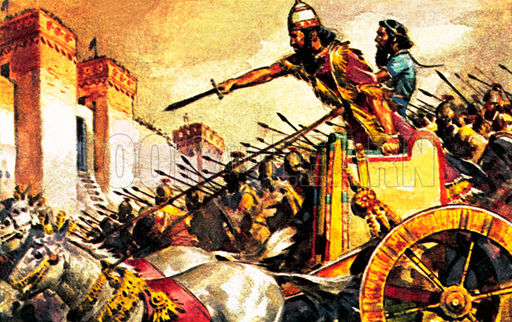The success of the Assyrian empire was not mere luck on the part of the Assyrian army. It was quite frankly anything but luck. They were considered the most efficient military force up until the time of their fall in 612 BCE. The Assyrians were known to be absolutely ruthless. Factors contributing to their success included their professionally trained army, their engineering skills, their well-developed tactics, and their all-important use of iron weaponry. Although use of iron for weaponry had already been capitalized on, the Assyrians are considered the first to take full advantage of the Iron Age.1
Previous to the use of iron, most weapons were made of bronze. Therefore, a majority of the Assyrians’ enemies were fighting with bronze weapons. The process for crafting these weapons out of iron required a quite different process than that of making bronze weapons. Iron, unlike bronze, needs to be heated and hammered. The Assyrians were lacking in resources and are believed to have been forced to master iron metallurgy rather quickly. Not only did making these weapons require new techniques, but also more time. Fortunately for the Assyrians, the use of iron increased the quality of armor as well as weaponry. While the use of iron made shields and helmets much heavier, it also allowed for greater protection.2

One of most notable weapons used by the Assyrians included the chariot. The chariot, originally a simple carriage drawn by donkeys, was introduced with horses by the Hyksos invaders of Egypt around 1700 BCE. The chariots were especially important for battlefield warfare because of their speed. Armor was most often worn by the chariot crews.3 Standard armor included a tightly fitted short sleeve jacket protecting the body and arms, as well as a loose skirt protecting the legs. The skirts were of different lengths; they could have been ankle length, thigh length, or slightly shorter. The full coat of armor was heavy, and for this reason, the armor was made into separate sections, making the weight better distributed.4 In addition to the body armor, Assyrians wore helmets of two types: pointed conical helmets and crested helmets.5
Often used by the Assyrians were daggers, which were different from what most would identify as a knife in that they have two cutting edges rather than one. Also used were swords. Similar to daggers, swords had two cutting edges, but were often larger in size. While a dagger was normally fourteen inches in length or less, a sword was often longer than twenty-eight inches. Remains of spearheads were found in more abundance than that of daggers and swords. Spearheads were essential to the Assyrian army. Spearmen served as the frontline troops in battle. While there are artificial remains of several different types of spearheads, they are nearly all made of iron.6
There is only a small quantity of artifacts from Assyrian military. Therefore, it is possible that part of the reason Assyrians were such a successful military force may remain a mystery. What can be said is that the Assyrians were militarily tactful, and masters of metallurgy. Eventually their lack of resources and size resulted in their fall; however, in history they will always be remembered as the strong, keen military force they were.
- Diana Haidar, “Assyrian Iron Working Technology and Civilization,” (Senior Thesis, The University Of Wisconsin Madison, 2011), 14–15. ↵
- World History Encyclopedia, January 2011, s.v., “Development Of Iron Arms And Armor,” by Tim J. Watts. ↵
- Salem Press Encyclopedia, January 2016, s.v. “Chariots in warfare,” by Elizabeth L. Meyers. ↵
- Amy E. Barron, “Late Assyrian Arms and Armour: Art Versus Artifact,” (Ph.D. Thesis, University of Toronto, Toronto, Canada, 2010), 168. ↵
- Amy E. Barron, “Late Assyrian Arms and Armour: Art Versus Artifact,” (Ph.D. Thesis, University of Toronto, Toronto, Canada, 2010), 179. ↵
- Amy E. Barron, “Late Assyrian Arms and Armour: Art Versus Artifact” (Ph.D. Thesis, University of Toronto, Toronto, Canada, 2010), 49, 79. ↵



35 comments
Johnanthony Hernandez
I did not know that the Assyrians lacked resources, I had thought that because of an abundance of resources that is why they had an effective military. I did know that they were brutal warriors but I didn’t know that it was because of the advancements that they made above everyone else or that it was due to what they used. When I think of the Assyrian army, I think of shield, sword, and spear. Not of daggers and chariots, great informative article.
Samuel Sanchez
Great read. Your article had a lot of useful information about the Assyrians that I did not know. I liked how you described their history with iron and their weaponry. Interesting to learn all types of weaponry they used and it would have been great if there was a description of their tactics. But overall you captured how great the Assyrians were and how they were advanced even though they had limited resources.
Erick Paul Martinez
Great article, it had a good flow that was easy to follow. Your article had a lot of useful facts on the Assyrians and the pride they took in their army. It was cool to learn of the different weapons they used, and how their weapons compared to their enemies. It allows the reader to better understand why they were so successful in battle.
Daniel Bailey
This was a very interesting article that helps us know more about the Assyrians and to know why they were victories at one point. Its fascinating to note that wars are a good way for people to reinvent or create new technology just so that they could have the upper hand. What started as a lack of resources was what forced the Assyrians to master other forms of metal crafting. The creation of the first iron swords would prove to be a significant impact by demonstrating the strength and potential that iron has. I find this article quite engaging to learn of how the Assyrians military impact would have drawn people out of the bronze age and into a new century.
Sergio Cervantes
I found it fascinating to learn of the first military that implemented the use of iron weapons within its ranks. The fact that mastering metallurgy placed them ahead of other militaries and gave them weapon superiority is just another reason as to why only certain empires were powerful throughout the ages. The little section about the armor, its weight, and how it was built separately was informative. It proved that the Assyrians were advantageous in many ways. It was great that you focused on an empire that existed before the Common Era.
Mario Sosa
I have never heard of the Assyrian empire before, so this article has given me a lot of insight into who they were and what they did. It surprised me to read how they were the first people to effectively utilize iron swords. The fact that they managed to be a successful military force with a limited number of resources is incredible.
Christian Lozano
A very well written and informative article. I did not know the Assyrians were such ruthless warriors, nor did I know they utilized Iron Age weapons. I always thought chariots were inherently Egyptian, but as I read, the Assyrians were among the first to capitalize on such a versatile piece of weaponry.
Erik Rodriguez
Awesome article! I have always been briefly informed about the Assyrians, but never into detail about their military force and weaponry. It’s quite amazing how they were capable of manipulating the craft of iron while ultimately establishing one of the most dominant army’s to have ever lived.
Overall, SUPER informative and well written article! Keep up the good work!
Joshua Tinajero
Wow, I never knew Assyrian uniforms varied slightly due to the length of their skirts, or that Chariot riders wore the most armor on the battle field. The application of iron weapons truly gave a great advantage to the Assyrian army. Keep up the good work!
Angelica Espinoza
This was very well written! It’s always interesting to learn the different metals that different cultures used to make their weaponry. I find it very interesting when older cultures use more advanced skills to craft them as well. Chariots are also so fun. It’s an interesting concept to have come up with and to use in war, but much more efficient than walking all the way as well. Great job explaining this, and such a great topic choice as well!